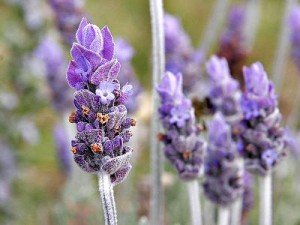Winter Prep For Spring Flowers
February 28, 2012 by
Filed under Blog
Getting Ready for Color
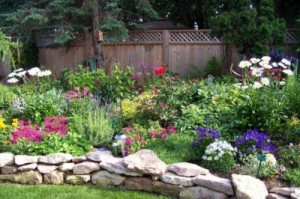
Last issue, we explored ways to bring flowers indoors to add color and cheer to our living spaces. Well, there is no better time than February to think about the outdoors … and begin making preparations to enjoy our plants and flowers in the spring, in their natural environment.
Depending upon the weather and planting season in your area, it may be time to ready your flower pots, boxes, beds and gardens for spring planting. If you haven’t quite thawed out yet, you can at least make your plans now for future action, and if you live in the drier, snow-free regions of the West, you can start your prep now.
Containers. If you do not have a garden, it is an easy thing to plant seeds or plants in pots on your patio, in small flower beds or in flower boxes. Clean up the outside of your pots to restore them to an attractive state. If they are faded or need some new life, consider painting them. Althoughsome people paint terra cotta pots, it isn’t recommended, as the soil and roots can “breathe” through the terra cotta clay. Don’t throw out that old soil–it is reusable (see Revitalize below). For you DIYers, flower boxes  and window boxes are easily made with scrap lumber, and you can, naturally, find dozens of plans and kits on-line. You may also find them in home improvement stores, as well as pre-made wood and plastic flower boxes in nurseries and garden centers. Also, don’t forget the beauty that hanging plants can add to your patio.
and window boxes are easily made with scrap lumber, and you can, naturally, find dozens of plans and kits on-line. You may also find them in home improvement stores, as well as pre-made wood and plastic flower boxes in nurseries and garden centers. Also, don’t forget the beauty that hanging plants can add to your patio.
 Revitalize your soil. If the soil in your garden or pots is dried out, treat or amend the soil by hydrating it well and mixing in compost or plant food. This will return those much-needed nutrients to the soil that may be absent. Those unopened bags of soil or potting mix, even if you’ve had them for months, may still be good, as long as the soil has remained as moist as when you purchased it. Soil doesn’t “expire,” but the nutrients can die off. One concern is whether or not the fertilizer in the soil mix is moldy. Take a good whiff of a newly opened bag, and if it smells bad (nastier than the “farm-fresh” scent of fertilizer), you don’t want to put it in a pot where it will continue its mold growth. It is best to put it in your compost pile or scatter it about your yard so that exposure to the air can kill the mold. If you don’t want it in your yard at all, throw it away, and it will eventually wind up in a landfill.
Revitalize your soil. If the soil in your garden or pots is dried out, treat or amend the soil by hydrating it well and mixing in compost or plant food. This will return those much-needed nutrients to the soil that may be absent. Those unopened bags of soil or potting mix, even if you’ve had them for months, may still be good, as long as the soil has remained as moist as when you purchased it. Soil doesn’t “expire,” but the nutrients can die off. One concern is whether or not the fertilizer in the soil mix is moldy. Take a good whiff of a newly opened bag, and if it smells bad (nastier than the “farm-fresh” scent of fertilizer), you don’t want to put it in a pot where it will continue its mold growth. It is best to put it in your compost pile or scatter it about your yard so that exposure to the air can kill the mold. If you don’t want it in your yard at all, throw it away, and it will eventually wind up in a landfill.
Gardens. If you do have a flower or vegetable garden, and have not maintained it throughout the winter, you will need to begin the weeding and tilling process to clean it up. You can improve the soil by adding organic matter, which should consist of one-third of your soil. This could be compost, grass clippings,  shredded newspaper, leaves, hay, peat moss, to name a few. These provide a food source for soil fungi and bacteria. If you have sandy soil, large amounts of organic matter will help it hold nutrients and water. If your soil is heavy clay, organic matter will improve aeration and drainage, and allow for better root development. Spread a layer of 2 to 4 inches of the organic matter on top of your soil, and till it to a depth of 6 to 10 inches. Be careful not to turn or till your soil if it is too damp, as the turned soil will dry into clumps as hard as rocks. Wait until it is just slightly dry. In addition to the organic matter, add just a little bit of bone meal to your soil to add phosphorous. This will stimulate root growth and flower production.
shredded newspaper, leaves, hay, peat moss, to name a few. These provide a food source for soil fungi and bacteria. If you have sandy soil, large amounts of organic matter will help it hold nutrients and water. If your soil is heavy clay, organic matter will improve aeration and drainage, and allow for better root development. Spread a layer of 2 to 4 inches of the organic matter on top of your soil, and till it to a depth of 6 to 10 inches. Be careful not to turn or till your soil if it is too damp, as the turned soil will dry into clumps as hard as rocks. Wait until it is just slightly dry. In addition to the organic matter, add just a little bit of bone meal to your soil to add phosphorous. This will stimulate root growth and flower production.
If you like to plant from seed, go ahead and get your seedlings started inside your home, perhaps in your laundry room or in a kitchen or bathroom window. In another month, they will be ready to go int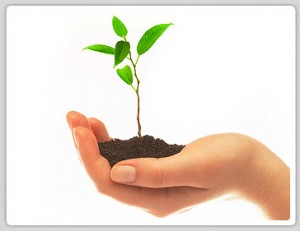 o the ground, and you’ll be ahead of the game. Before you plant them, however, start to acclimatize them by putting them in your garage so they can begin to become accustomed to the weather change from the inside of your house to the outside. If you don’t have a garage, set them outside for an hour or two each day until the weather is warmer and it’s time to plant.
o the ground, and you’ll be ahead of the game. Before you plant them, however, start to acclimatize them by putting them in your garage so they can begin to become accustomed to the weather change from the inside of your house to the outside. If you don’t have a garage, set them outside for an hour or two each day until the weather is warmer and it’s time to plant.
Mulching with shredded bark is very good for your garden and your potted plants. It will keep the soil moist and keep the weeds down, but if you don’t stir it around regularly, it can cause mold growth.
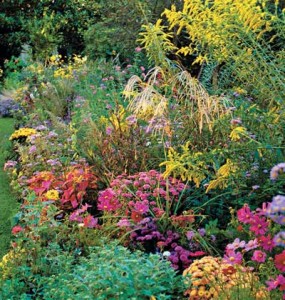 Get creative with your flower planting, mixing annuals and perennials and multiple colors. In addition to your flower beds, consider other areas of your yard, garden or patio that could benefit from a burst of color. Plant flowers at the base of your trees, in the ground, in pots or both. If you have bare patches of ground next to your house or next to a fence that could benefit from a splash of color, amend the soil and add a flowering plant, vine or flowers. How many times have you considered putting up a trellis in that corner or on that wall? Start sh
Get creative with your flower planting, mixing annuals and perennials and multiple colors. In addition to your flower beds, consider other areas of your yard, garden or patio that could benefit from a burst of color. Plant flowers at the base of your trees, in the ground, in pots or both. If you have bare patches of ground next to your house or next to a fence that could benefit from a splash of color, amend the soil and add a flowering plant, vine or flowers. How many times have you considered putting up a trellis in that corner or on that wall? Start sh opping for one now, as well as the flowering vine you like so much, and when it is time to plant, get them both in the ground! Add personality and style by creating a rock border around a garden patch, or perhaps even set in a rock or flagstone pathway in just the right spot. If you want to attract hummingbirds, plant flowers that will entice them (bright colors and blooms that hang downward).
opping for one now, as well as the flowering vine you like so much, and when it is time to plant, get them both in the ground! Add personality and style by creating a rock border around a garden patch, or perhaps even set in a rock or flagstone pathway in just the right spot. If you want to attract hummingbirds, plant flowers that will entice them (bright colors and blooms that hang downward).
We have only four weeks left until the official start of spring, so you have time to do some research, make your plans, write out a list, do your shopping and get ready. As soon as it’s warm enough to plant in your area, get to it! The sooner you do, the longer you will be able to enjoy the color and beauty of your flowers.
?>A Feel For Flowers
Floral Decorating in Your Home
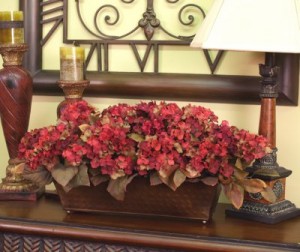
Valentine’s Day is just around the corner, when thoughts tend towards love, chocolate and … flowers, flowers, flowers! Flowers are always a wonderful gift, whether you give them to someone else or purchase them for yourself. For a special touch of style and flair, why not treat yourself and add a spritz of color and nature to your living space?
There are a number of ways to decorate your home with flowers. First of all, they definitely do not have to be fresh to be enjoyed. While dried flower arrangements aren’t quite as popular today, the quality of silk flowers has improved so dramatically, that they can pass for the real thing and last much longer … and they’re perfect for those with allergies!
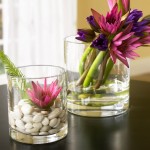 Vases. You may not wish to store oodles of vases, but you can easily use what you have (your own small drinking glasses, for example), and add to your collect
Vases. You may not wish to store oodles of vases, but you can easily use what you have (your own small drinking glasses, for example), and add to your collect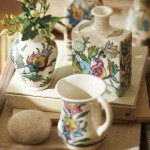 ion over time. A popular use of vases is ingroupings, large and small. Consider a grouping of vases on window sills, counters, shelves, mantels, or on any table in any room to provide a bright splash of cheer. If you have them, use some of your own garden flowers in small vases. We tend to overlook the smallest flowers, but they add such a delicate touch in tiny vases. If you grow or buy VERY long-stemmed flowers, like gladiolas, for instance, they can be placed in either table or floor vases. Don’t overlook the use of tall floor vases.
ion over time. A popular use of vases is ingroupings, large and small. Consider a grouping of vases on window sills, counters, shelves, mantels, or on any table in any room to provide a bright splash of cheer. If you have them, use some of your own garden flowers in small vases. We tend to overlook the smallest flowers, but they add such a delicate touch in tiny vases. If you grow or buy VERY long-stemmed flowers, like gladiolas, for instance, they can be placed in either table or floor vases. Don’t overlook the use of tall floor vases.
 Wall Sconces. Another fun way to use flowers is in wall sconces. We all have a couple of spots on our walls that we just can’t figure out how to fill. Wall sconces are made of several materials, but you’ll usually find them in lightweight metal, and they are typically in neutral brown tones to go with any decor. You will find a multitude of shapes and designs to please any taste, and you can certainly paint them to match your own color scheme.
Wall Sconces. Another fun way to use flowers is in wall sconces. We all have a couple of spots on our walls that we just can’t figure out how to fill. Wall sconces are made of several materials, but you’ll usually find them in lightweight metal, and they are typically in neutral brown tones to go with any decor. You will find a multitude of shapes and designs to please any taste, and you can certainly paint them to match your own color scheme.
Wall Art. Don’t hesitate to use wall art to add that brilliant splash of floral color to your home. Floral prints NEVER go out of fashion. Chances are you already have a few adorning your walls! If you wish to preserve your favorite, once-fresh flowers, you can find helpful instructions on-line for pressing and preserving them. Why not get creative? Place your pressed flowers in a frame and make your own floral wall art.
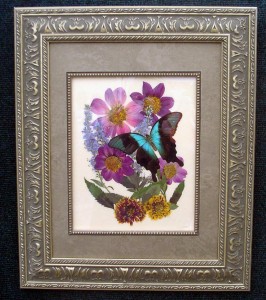
Odds are you may have or can find endless ideas for decorating your home with flowers. May your imagination blossom!
